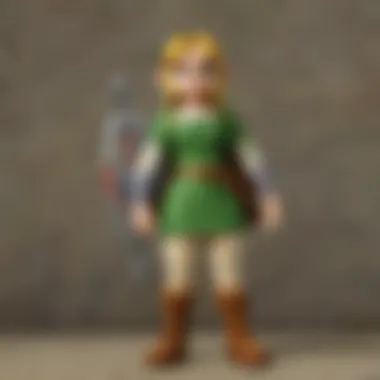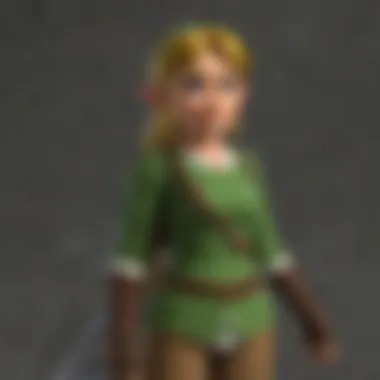Understanding the N64 Expansion Pack in Zelda


Intro
The Nintendo 64's expansion pack arrived in the mid-1990s, introducing significant enhancements to the gaming experience. This accessory was particularly impactful for titles like The Legend of Zelda: Ocarina of Time and Majora's Mask. By increasing the console's RAM, the expansion pack enabled developers to create richer environments and more complex gameplay elements. This advancement is crucial to understanding how the Zelda series evolved during this era.
The expansion pack played a pivotal role, allowing for improved graphics and gameplay features that set these titles apart from their predecessors. The enhancements also altered how players interacted with the game world, providing a more immersive and expansive experience.
In this article, we will examine various aspects of the expansion pack in relation to the Zelda series. We will analyze game reviews, character insights, lore discussions, and gameplay strategies that highlight its significance in this classic franchise.
Understanding these elements will provide a comprehensive overview of how the N64 Expansion fundamentally reshaped the Zelda experience and contributed to its lasting legacy in gaming history.
Prologue to the N64 Expansion
The introduction of the Nintendo 64 Expansion Pack marked a significant milestone in the evolution of gaming hardware. It not only enhanced gameplay experience but also offered deeper immersion for players, particularly in the Zelda franchise. This article explores the multi-faceted impact of this expansion on titles such as The Legend of Zelda: Ocarina of Time and Majora's Mask. By examining the expansion's historical context, technical specifications, and its effect on gameplay, we provide a deeper understanding of its role in shaping modern gaming.
Historical Overview
The N64 Expansion Pack was released in 1998, during a time when video game technology was rapidly advancing. Games were transitioning from 8-bit and 16-bit graphics to more complex 3D environments. The Nintendo 64, launched in 1996, was already making strides with its innovative graphics and gameplay, but the Expansion Pack pushed the boundaries further. It was primarily designed to enhance the system’s memory capacity from 4MB to 8MB. This additional memory allowed developers to create more detailed game worlds and richer graphics. Initially created for The Legend of Zelda: Ocarina of Time, the Expansion Pack was fundamental in allowing the developers to realize their vision in a way that was not previously possible.
The idea of an add-on was not new in gaming. Other consoles had similar expansions, which created a precedent. The Expansion Pack was Nintendo's first significant step towards dealing with hardware limitations through upgrades, and it set a precedent in the industry for future enhancements. It not only connected the past and present of gaming technology but also paved the way for future consoles.
Launch and Development
When it came to its launch, the expansion was announced alongside highly anticipated titles, which created excitement among the gaming community. Nintendo's development cycle for the expansion was meticulous. Key developers were aware of the limitations of the N64's standard memory and focused on creating vibrant worlds that could be more than just visually appealing. The main challenge was to integrate the Expansion Pack seamlessly into existing games.
The development of The Legend of Zelda: Ocarina of Time benefited immensely from the pack. Designers aimed to craft a compelling narrative supported by immersive visuals. However, the development required additional resources and time. The end result was a game that not only captured players’ imaginations but also showcased the potential of the N64’s capabilities. The Expansion Pack's integration into the universe of Zelda was not just a linear enhancement; it became part of the series' legacy. This development phase shaped both player expectations and the industry standard for future upgrades in gaming systems.
Technical Specifications of the N64 Expansion
The technical specifications of the Nintendo 64 Expansion Pack are crucial to understanding its role in enhancing the gaming experience for titles like The Legend of Zelda: Ocarina of Time and Majora's Mask. The expansion was designed to address certain limitations of the original Nintendo 64 console, providing both memory enhancement and improved graphics capabilities. This section will detail these specifications and their impact on gameplay.
Memory Enhancement
The N64 Expansion Pack increased the system's RAM from four megabytes to an impressive eight megabytes. This upgrade was significant for several reasons. First, it allowed for larger and more detailed game environments, which directly contributed to a more immersive gameplay experience. For instance, the enhanced memory enabled developers to incorporate richer textures, more character models, and improved draw distances. This meant that players could explore larger environments without encountering the graphical glitches or slowdowns often associated with limited memory.
Moreover, the additional memory supported advanced features in game design. In Ocarina of Time, it facilitated immersive cutscenes and allowed for complex animations that brought the game's story to life in a way not possible before. In essence, the memory enhancement was not just a technical improvement; it catalyzed the evolution of storytelling within the Zelda series.
Improved Graphics Capabilities
The graphics capabilities of the N64 Expansion Pack cannot be understated. While the original Nintendo 64 was already a leap forward in 3D graphics for its time, the expansion took this a step further. It allowed for higher resolution textures and more polygonal shapes in character models and environments.
This increase in graphical fidelity was especially apparent in Majora's Mask. The darker and more atmospheric aesthetic required better graphical handling to represent its unique art style. The N64 Expansion Pack ensured that the game maintained fluid animation and impressive visual effects, such as fog and lighting changes.


Additionally, the expansion enabled the use of the High-Resolution Texture mode, which further enhanced the visual quality. Players noticed sharper images and more detailed character expressions, improving immersion and emotional connection to the game.
"The N64 Expansion Pack extended the game's visual capabilities, creating a more engaging and visually stunning world for players to explore."
Impact on Ocarina of Time
The impact of the N64 Expansion on The Legend of Zelda: Ocarina of Time cannot be overstated. While the game originated as a groundbreaking title, the expansion pack brought significant improvements that enhanced the gameplay, graphics, and overall player experience. The expansion is often viewed as a vital part of the game's evolution, enabling developers to craft a more immersive and richer world for players to explore.
Enhanced Gameplay Features
With the N64 Expansion, Ocarina of Time introduced new gameplay features that significantly altered the player experience. One of the most notable enhancements was the introduction of higher resolution textures, which allowed for more intricate environments and character designs. The expansion provided the hardware capability to process these richer textures, creating a more lifelike atmosphere that drew players further into the game world.
Furthermore, the expansion enabled additional gameplay modes and mechanics. Features such as improved draw distances became apparent, allowing players to view expansive landscapes without the visual limitations that characterized earlier releases. These changes encouraged exploration and made Hyrule feel like a more vast and believable space.
Graphical Improvements
Graphical enhancements were a hallmark of the N64 Expansion's effect on Ocarina of Time. The increased memory capacity permitted richer visual details, which were crucial for creating a believable fantasy world. Character models became more detailed, animations were smoother, and environments were teeming with life, all thanks to the expanded graphical capabilities.
The visual improvements extended beyond mere aesthetics. Certain scenes that relied on dramatic lighting and shadows benefited greatly from the expansion. These effects heightened the emotional impact of key story moments and provided a more atmospheric experience. The game not only looked better but also conveyed a deeper emotional resonance with players.
Additional Content and Quests
The impact of the N64 Expansion also extended to content availability within Ocarina of Time. It allowed for additional quests and side missions that were previously not feasible due to hardware constraints. Players could delve into more content beyond the main story, making the game feel more substantial and rewarding.
Several side quests were intricately designed, encouraging players to engage with the world on a deeper level. Collectible items, secret areas, and new challenges could be explored, providing a sense of accomplishment. The expansion turned what was already an exceptional game into a more diverse and engaging experience for those who sought to uncover every secret Hyrule had to offer.
"The N64 Expansion transformed the gaming experience, providing not just enhancements, but a new dimension to the gameplay that defined how players interacted with Hyrule."
Influence on Majora's Mask
The Nintendo 64 Expansion Pack had a notable influence on the design and overall experience of The Legend of Zelda: Majora's Mask. This installment in the beloved franchise pushed the boundaries of what players could expect from a game during that era. By utilizing the expanded capabilities, the developers were able to enhance various aspects of the game that added depth and complexity to its narrative and gameplay features.
Incorporation of Expanded Features
One of the significant elements introduced through the N64 Expansion Pack in Majora's Mask was the capacity for richer textures and larger environments. The additional memory allowed for a more detailed representation of the intricate landscapes of Termina. This resulted in not just enhanced visuals but also an increase in the overall immersiveness of the game. Players could explore more substantial areas without experiencing lag, which was critical given the time-based mechanic of the game.
The use of new gameplay mechanics such as the three-day cycle was done with additional room to create a more complex world. With the enhanced hardware, developers were free to incorporate more NPCs, dynamic events, and intricate quests. The existence of diverse characters like the masked transformations of Link could be developed further, giving players new abilities and gameplay styles which was enabled by the expanded hardware.
Narrative and World-Building Enhancements
The storytelling in Majora’s Mask was heavily influenced by the expansion capabilities. The ability to detail the interactions among characters enabled a richer narrative. Each character had their own story which unfolded with depth that previous titles did not venture into. The game's themes of time, mortality, and consequence were explored more thoroughly due to this capability. The emotional weight of decisions and their impact on the world became more pronounced.
Furthermore, the world-building aspect was also advanced, with the N64 Expansion allowing for a broader representation of Termina's unique culture and environment. The variation in different regions, each with its calendar-based events, forgone dialogues. This depth of lore gave players an experience that felt both vast and intimate.


"The Expansion Pack was crucial in allowing Majora's Mask to achieve its distinctive narrative style and emotional storytelling. Without it, the game would not have been the same."
The blending of enhanced graphics with deep narrative design created a cohesive gameplay experience that resonated deeply with players. Thus, the influence of the N64 Expansion Pack cannot be understated when analyzing Majora’s Mask and its pivotal position within the Zelda franchise.
Gameplay Changes with the Expansion
The addition of the N64 Expansion Pack notably transformed gameplay within the Zelda titles, particularly in Ocarina of Time and Majora's Mask. This section examines how the expansion altered core game mechanics and introduced new features that enhanced the players' experiences. Understanding these changes is crucial to appreciating the overall impact of the expansion on the Zelda franchise.
New Gameplay Mechanics
With the N64 Expansion Pack, players encountered several new gameplay mechanics that had not been available in the original versions of the games. One significant change was the implementation of the use of additional items. Players could now utilize items like the Goron’s Sword and Great Fairy upgrades more effectively. This increased the complexity of combat scenarios and opened new avenues for strategic gameplay.
Another notable addition was the introduction of more expansive environments. The expansion allowed for larger areas to be created in both games, encouraging exploration and interaction. In Majora's Mask, for instance, the larger space allowed for more intricate side quests, providing depth and enhancing the player’s engagement with the game world.
Some other mechanics included:
- Dynamic weather and time system: These features made the world feel alive and reactive to player actions.
- Enhanced AI behaviors: NPCs could react to more varied player actions, resulting in a more immersive experience.
Overall, these gameplay mechanics not only addressed previous limitations but also enriched the narrative structure of the games, undoubtedly heightening the enjoyment factor for fans.
Difficulty Adjustments
Along with new mechanics, the N64 Expansion also brought about adjustments in game difficulty. Ocarina of Time and Majora's Mask both faced criticism for their balancing in terms of challenge and ease. The expansion acknowledged these issues and introduced adjustments to optimize difficulty.
One significant aspect of this was the fine-tuning of enemy encounters. The expansion modified enemy stats, improved their attack patterns, and increased their AI responsiveness, making battles more challenging and rewarding. This change meant that players had to develop more thoughtful strategies when engaging enemies, thus heightening the satisfaction upon overcoming challenges.
Furthermore, the expansion made modifications to puzzle designs. Certain puzzles were given extra layers or complexity, ensuring that players had to think critically to solve them rather than relying purely on trial and error. This thoughtful adjustment significantly enhanced the gameplay experience.
In summary, the N64 Expansion Pack implemented meaningful gameplay changes that not only introduced new mechanics but also refined the overall difficulty. These developments were critical to ensuring that both Ocarina of Time and Majora's Mask remained engaging and relevant within the gaming landscape.
Critical Reception of the N64 Expansion
The critical reception of the Nintendo 64 Expansion Pack offers invaluable insights into its influence on gaming, particularly its long-term effects on the Zelda series. By evaluating both reviews and the overall legacy, one can grasp how the expansion shaped perceptions and expectations in the gaming community. This assessment highlights specific elements such as enhanced gameplay experiences and graphical improvements, which were notable points of discussion among critics and players alike.
Reviews and Ratings
Upon its release, the N64 Expansion Pack received a range of reviews from gaming magazines and websites. The initial response can be characterized by a mix of enthusiasm and critique. Many praised the boost in graphical fidelity and the added memory capacity, which allowed games like Ocarina of Time and Majora's Mask to expand their narratives and environments.
For instance, Ocarina of Time, with the Expansion Pack, achieved higher polygon counts for characters and richer environments. Reviews highlighted the smoother framerates and improved draw distance, resulting in a more immersive experience. On websites and platforms like Reddit, users frequently discussed how the enhancements deeply transformed gameplay, citing the dramatic improvements in performance.
However, not all reviews were positive. Some gamers argued that the expansion was not essential for enjoying the games in their original forms. Critics pointed out that while the enhancements were impressive, they came at an additional cost that some players felt was unjustifiable. The mixed reception was evident in various ratings, which reflected a division among players based on their gaming preferences and expectations. Overall, it was recognized that the Expansion Pack enriched the experience for those who chose to use it but left some gamers satisfied with the original specifications.
Legacy and Long-Term Impact


The legacy of the N64 Expansion Pack stretches beyond its immediate release and reviews. Over the years, it has become more than just a supplement; it has laid groundwork for future gaming expansions and hardware improvements. As gaming technology continues to advance, many developers refer back to moments like this to understand player desires for enhanced experiences.
One significant aspect of its legacy is its influence on future Nintendo hardware. Many features introduced in the Expansion Pack can be seen in later consoles, promoting an idea of regular upgrades. Furthermore, today’s gaming landscape still grapples with how additional content can be integrated efficiently into existing frameworks. The expansion demonstrated that developers could push boundaries, enhancing player engagement through hardware improvements.
In addition, the conversations surrounding its legacy have persisted on forums and social media platforms like Facebook, where gaming communities recognize its place in history. The expansion played a key role in how fans perceive the Zelda franchise and Nintendo’s approach to game longevity. The conversations highlight a deeper appreciation for how enhancement packs can round out gameplay, often sparking debates among gaming enthusiasts about the value of additional investments in hardware.
"The N64 Expansion Pack was pivotal in shaping what we expect from gaming experiences today. It sparked a culture of upgrades that continues to influence players and developers alike."
This direct connection from the past to future systems solidifies the impact the Expansion Pack had on the gaming universe and the strategies used to cater to dedicated fans.
Comparative Analysis with Other Hardware Expansions
The examination of the Nintendo 64 Expansion Pack’s influence necessitates a look at other hardware expansions in the gaming industry. This comparative analysis will unveil valuable insights regarding the purpose, features, and legacies these expansions left behind. By understanding the strengths and weaknesses of the N64 Expansion alongside its peers, one can appreciate how it enriched the Zelda franchise and shaped expectations for subsequent gaming hardware upgrades.
Similar Expansions in Gaming History
Numerous gaming consoles throughout history have featured hardware expansions aiming to enhance performance and overall gameplay experience. For instance, the Sega Genesis had the Sega CD and later the 32X, which aimed to extend the console’s lifecycle and bolster its capabilities. Similarly, the Atari Video Music offered an audio enhancement feature, and various PC platforms have seen expansions that targeted improved graphics and speed.
In looking at the Nintendo 64’s endeavors, the expansion pack stands as a unique case. Unlike others that merely added extra peripherals, the N64 Expansion acted as a vital component that integrated directly with the system’s performance, enhancing the core experience rather than functioning as an afterthought. This element of direct integration proved more impactful in games like Ocarina of Time and Majora's Mask than many other expansions.
It is essential to note that while some expansions have been critiqued for failing to deliver on their promises, the N64 Expansion is often credited with reinforcing the quality of the titles it supported. Key examples of such expansions, alongside the N64 Expansion, include the PlayStation's DualShock functionality that added analog control and vibration feedback, and the Xbox 360's Kinect, which altered gameplay by introducing motion sensing. However, the effectiveness can vary widely; while some expansions were largely gimmicks, others provided tangible gameplay benefits.
Effectiveness in Enhancing Gameplay
Evaluating the effectiveness of hardware expansions involves considering how they fundamentally shift gameplay mechanics and user engagement. The Nintendo 64 Expansion enriched Ocarina of Time and Majora's Mask in several ways:
- Increased Memory: The expansion added RAM, allowing for larger worlds and more complex gameplay elements.
- Enhanced Visuals: It enabled higher-resolution graphics, making for a more immersive experience.
- New Game Features: Titles like Majora's Mask incorporated more side quests and character interactions, thanks to the expansion's capabilities.
While the benefits of hardware expansions can sometimes be overstated, the N64 Expansion brought about significant advancements that distinctively improved gameplay. Many players regard the enhancements as essential components of their experience, showcasing how expansions should not just be seen as peripheral accessories, but as necessary instruments for the evolution of gaming.
"The N64 Expansion was a testimony to how focused technology integration can truly enhance a gaming experience, setting a standard for future gaming hardware designs."
Finale
The conclusion of this article plays a vital role in synthesizing the insights gathered from previous sections, providing a comprehensive wrap-up of how the N64 Expansion Pack has shaped the Zelda experience. Understanding this aspect allows fans and new players alike to appreciate the depth and evolution of the games. It is essential to recognize the historical significance of the expansion, as it was one of the first major enhancements in gaming that led to a richer gameplay experience.
Summary of Key Points
In summary, the N64 Expansion Pack transformed both Ocarina of Time and Majora's Mask. Here are the key points:
- Memory Enhancement: The expansion effectively doubled the RAM from 4 MB to 8 MB, allowing for more complex environments and better NPC interactions.
- Graphical Improvements: The upgrade facilitated higher-resolution textures, leading to a more visually appealing game world.
- New Gameplay Mechanics: Unique features were added, such as the ability to explore entirely new areas and utilize improved character control.
- Critical Reception: Both games received high praise for their advancements due to the expansion, paving the way for future titles to consider hardware enhancements as necessary for growth.
- Legacy: The expansion marked a turning point in how game developers approached design and technology integration.
Future Implications for Gaming
Looking towards the future, the impact of the N64 Expansion could provide insights into expanding hardware capabilities in current and upcoming gaming consoles. Game designers may consider the balance between graphical fidelity and gameplay creativity as a way to enhance player immersion. Furthermore, with evolving technologies like virtual reality and cloud gaming, hardware expansions could take on a new form.
- Future developers can learn from the past expansions, applying similar concepts of flexibility and adaptability.
- Enhanced player experience remains a priority, and understanding historical advancements could drive innovation.
- The success of the N64 Expansion demonstrates that hardware can significantly alter not just the visual aspects of a game but also the depth of its story and gameplay mechanics.
"Technology's advance opens doors; it is up to the creators to navigate through them."







